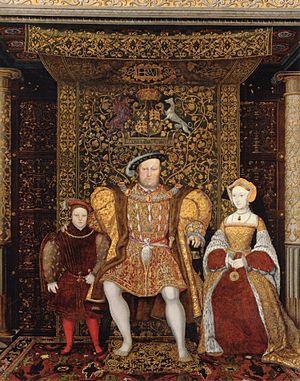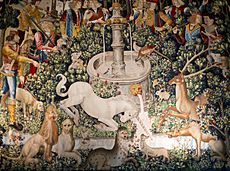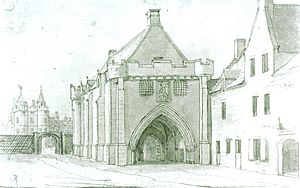Scottish royal tapestry collection facts for kids
The Scottish royal tapestry collection was a special group of beautiful woven wall hangings. These tapestries were gathered to decorate the palaces of Scotland's kings and queens in the 1500s. They made royal rooms look grand and important.
Contents
Royal Tapestries: A Sign of Power

Kings and queens across Europe loved to show off their wealth. They used expensive tapestries to impress visitors. For example, the King of France once helped an English ambassador look closely at a tapestry. This showed how important these artworks were.
In Scotland, King James V had many tapestries. They were listed with his crown jewels and fancy clothes. These tapestries hung in the best rooms of his palaces. Special workers moved them between homes. They also fixed and hung them carefully. Rooms often had painted designs at the top of the walls. The tapestries hung below these designs. King Henry VIII of England owned almost 2,000 tapestries. James V had about 200.
Sadly, eleven royal tapestries were lost in a big explosion. This happened at Kirk o' Field in February 1567. No original Scottish royal tapestries are known to exist today. But we know their names and what they showed. Many were like tapestries in other royal collections. Some of these still exist in museums. Some Scottish tapestries showed Bible stories. Others showed old medieval tales. Most, however, featured stories from ancient Greece and Rome. This was a popular style during the Renaissance. Some also showed exciting hunting scenes.
Records of Royal Tapestries
King James V's Collection
Two lists from 1539 and 1543 show King James V's tapestries. Some of these had belonged to his father, James IV. However, some old royal hangings were cut up for clothes. Many tapestries were bought by James V himself. Others were gifts from the King of France. He received them when he married Madeleine of Valois. A record from 1532 shows James V ordered a tapestry for an altar. It was made by François van Cralotte in Bruges.
Later, in September 1561, a list was made of tapestries. These belonged to Mary of Guise, James V's wife. Another list from November 1561 showed Mary, Queen of Scots' collection. These lists often had notes about where the tapestries went. Mary, Queen of Scots, added to the collection. She took 45 tapestries from the Earl of Huntly. This happened at Huntly Castle in October 1562. These included tapestries with large leaves. Others showed leaves and birds. Five of the eleven tapestries lost at Kirk o' Field were from Huntly. The others were from a set showing a "Rabbit Hunt."
Regent Moray and Mary's Belongings
After the battle of Langside in May 1568, Regent Moray took back royal tapestries. These were from Hamilton Palace. They had belonged to James V. Packing materials were bought for items taken from Hamilton Castle. This included some royal tapestries. Boxes and trunks from Hamilton were taken to Edinburgh. Horses carried them, watched by a gunner named Harry Balfour.
Mary had lent some tapestries to James Sandilands, 1st Lord Torphichen. These were taken to Hamilton. Later, he was asked about them. He said soldiers had damaged and scattered them. They were dragged on sleds through muddy areas. No one cared about keeping them safe at Hamilton. Regent Moray might have sold some tapestries abroad in 1568. He also sold some of Mary's pearls and jewels. Mary, who was then a prisoner in England, complained. She said Scottish ships brought her clothes and jewels to English ports for sale.
Tapestries at Stirling Castle
A list from March 1579 showed tapestries. Some were in Edinburgh Castle. Others were hanging at Stirling Castle. This is where James VI lived. Tapestries at Stirling included eight pieces of the Judgement of Paris. There were also four pieces of the Hunt of the Unicorn. Other sets showed Roboam, the "Triumph of Verity", and the Count of Ravenna. There was also the History of Aeneas and the Story of Tobit. One hanging had the arms of the Dukes of Longueville.
Other furnishings at Stirling included special cloths. These were called "cloths of estate." They were made of velvet or cloth of gold. They hung above the king's chairs and thrones. There were also three fancy state beds. One was red velvet with love knots. Another was gold and silver cloth with flowers. The third was crimson velvet. These beds and cloths were in the king's main rooms.
Some tapestries at Stirling had been there for decades. Others had been stored in Edinburgh Castle. In June 1578, large tapestries were shipped from Leith. They went to Cambuskenneth and then to Stirling Castle. A list from May 1584 shows tapestries in the king's audience room. There were five pieces. Seven tapestries were in his bedchamber. The other furnishings from James VI's childhood were likely moved to Holyroodhouse.
Mary, Queen of Scots in England
When Mary moved to Tutbury Castle in February 1569, she received tapestries. Three sets were sent from the Tower of London. These included six pieces of the Passion. There were also six pieces of the History of Ladies. Seven pieces showed Hercules. The last two subjects were also in earlier Scottish lists. At Sheffield Manor in February 1577, Mary had her own Aeneas and Meleager tapestries.
In January 1585, Mary was moved again. Queen Elizabeth thought Mary had received items from Regent Moray. But Mary's jailer said this was not true. Mary used tapestries to line her cold bedchamber at Tutbury. This made it like a warm tent. At Fotheringhay in 1587, she had six pieces of Meleager. She also had six pieces of the Battle of Ravenna. She wanted these sold to pay for her servants' trips home.
James VI and Anne of Denmark
Tapestries were carefully fixed in 1594. This was for the baptism of Prince Henry at Stirling Castle. After James VI became King of England too, he got more tapestries. He bought new ones from merchants. One merchant, Francis Spiring, sold him a set of three or five pieces in 1607.
In October 1615, King James ordered tapestries for Stirling Castle. They were to furnish two rooms for Lord Erskine. Some tapestries stayed at Dunfermline Palace in 1616. Alexander Seton, 1st Earl of Dunfermline had looked after Prince Charles there. There were also tapestries at Linlithgow Palace. They had furnished a bedchamber for Prince Henry. A fool named Andrew Cockburn had cut it.
In 1617, three pieces of green velvet tapestries were repaired. They had gold holly leaves and the Longueville family arms. These had belonged to Mary of Guise. They were used when James visited Scotland. In 1635, King Charles I ordered payment for wardrobe servants. This was so tapestries and beds could be aired. The remaining tapestries at Holyrood would have been taken by soldiers in 1650. In 1656, soldiers found four pieces of the Labours of Hercules. These were likely the last mention of the Scottish royal tapestries.
The Tapestry Collection's Stories
Tapestries Bought in Paris
Six pieces called the Triumphant Dames were bought in Paris. This was in 1537 or 1538. They were purchased during James V's trip to marry Madeleine of Valois. These tapestries were sent to Scotland by boat. Another set, called the Old and New Stories, was also shipped.
A similar set, New Law and the Old, was owned by Catherine of Aragon. The Scottish set was probably the ten-piece Old Testament from the 1539 list. Only one piece was noted in 1542. None were heard of again in Scotland. James V sent a servant to Flanders for more tapestries. He also hired a French tapestry worker named William.
When Mary, Queen of Scots was a prisoner, six pieces of the History of Ladies were sent to her. These were likely from Henry VIII's collection. They had decorated the childhood homes of Princess Elizabeth and Prince Edward. The story came from a book called The Book of the City of Ladies. Other rulers also owned tapestries on this subject.
Another tapestry bought in Paris was the Creation of World. Nine pieces were at Holyroodhouse in 1561. They were in Edinburgh Castle in 1578. In 1616, Alexander Seton had some old pieces called the Storie of Mankynd. This set might have been The World series. It showed moral lessons and a globe. A History of the Creation of the World was at Hampton Court in 1613. It showed God as three people.
Wedding gifts from Francis I included four sets of rich Arras hangings. He also gave eight sets of coarser Arras. These gifts would have been in the Scottish lists. In 1546, a merchant offered Mary of Guise more tapestries. But it's unlikely any were bought then.
Tobias and the Angel, and the Lost Child
The Tint Barne, or History of the Lost Child, might seem like the History of Tobias. However, the five-piece Tobias was listed in 1539 and 1542. The seven-piece Tint Barne was listed separately. The Tint Barne was probably about the Prodigal Son. This story was popular and owned by many, including Henry VIII.
Ancient History Tapestries
These tapestries were delivered in 1539. They were a group of five or six sets, each with seven pieces. They included "Sundry pieces histories of Chambers." More were bought in 1541. The word 'chamber' here meant a set of tapestries. It did not mean a specific room.
Stories supplied in 1539 included Poesy and Jason and Golden Fleece. There were also pieces about Venus, Pallas, Hercules, Mars, Bacchus, and Gaia. The Bible story of Solomon was also included. Only six pieces of Jason were listed in 1542. Four pieces of Solomon were at Stirling around 1568.
The seven-piece History of Perseus was likely part of this group. James IV had bought one piece of Hercules. Nine pieces were listed in 1542. This was a different set from the Hercules in the ancient god series. A three-piece History of Romulus was listed in 1542. The Old History of Troy was listed in 1539 and 1542. It was already old and worn out.
Thirteen pieces of the History of Aeneas were moved in May 1539. Eight pieces of the Sailing of Aeneas were at Holyroodhouse in 1561. They were later at Stirling Castle. In 1578, there were eight Sailing pieces and four others. The extra tapestry might have been from the Old History of Troy. Or the Sailing of Aeneas set might have been new from France. Alexander Seton had some of the Aeneas and Troy pieces in 1616. A garden area at Holyroodhouse was called the Sege of Troy. Perhaps tapestries were aired there.
The Meleager Tapestry
This was a separate story from Jason. It was listed in 1539 as the History of Maliasor. This six-piece Meleager tapestry was at Fotheringhay Castle in 1587. It was Mary's own possession. Mary also had six pieces of the History of Count Foix and the Battle of Ravenna. This set was first listed in 1561. So it might not have belonged to her parents. Mary wanted the Meleager and Ravenna tapestries sold after her death. This would pay for her servants' trips home. The Bible story of Roboam also appears in most lists from 1539.
Triumph and Assault of a Town
This tapestry might have been a copy of a famous French one. It showed the story of Scipio Africanus. This included a scene of the Siege of Carthagena. However, these five pieces were first listed in November 1561. So they might not have belonged to James and Mary of Guise. Other old tapestries showed a Siege of a Town. This might fit the description. Another idea is that these were scenes of the Siege of Troy.
Unicorns, Apes, and Other Beasts

James V's other tapestries included six Great and eight Little Unicorn pieces. The Great Unicorn set is thought to be another version of The Hunt of the Unicorn. These famous tapestries are now in New York. Copies are being made for display at Stirling Castle. These unicorn tapestries had belonged to James IV. The unicorn story was still popular in 1540.
Seven pieces of the History of the Apis and uther Bestis were recorded in 1539. Six pieces of the History of Apes were recorded in 1561. In January 1563, three pieces of this monkey tapestry were given away. Mary Queen of Scots gave them to a court officer.
A list from September 1561 shows ten pieces of History of Hunting and Hawking. This might have been a separate item. It may have belonged to James V. It might be different from the Hunting of the Sanglier (Wild Boar) set. And also different from the Coningars (Rabbit Hunt) set. One scene from the Rabbit Hunt was lost at Linlithgow Palace. This was during the 1566 baptism of James VI. But this loss was recorded earlier, in 1565. The other six pieces were destroyed in the Kirk o'Field explosion. Another "Rabbit Hunt" tapestry was made into bed curtains. The Burrell Collection in Glasgow has a similar tapestry from around 1475.
James IV bought one scene of Marcus Coriolanus. This might be the Mathiolus tapestry. He also bought a Solomon tapestry. This might be the Judgement of Solomon.
The History of the Shepherds (seven pieces) and the History of Calveris and Moris (four pieces) were noted in 1561. Their subjects are not clear. The eight-piece Triumph of Verity was also noted in November 1561. It might have come with Mary in 1561. Or it might be another name for the City of Dames.
The Tapestry Workers
Margaret Tudor's wardrobe worker, Harry Roper, cared for tapestries. He mended them and made them smell nice. Hooks for hanging tapestries were bought.

James IV built a gatehouse at Holyrood Palace. He put a glassmaker there. In 1537, James V moved the glassmaker's shop. The gatehouse was then used for mending tapestries.
A French tapestry worker named Guillaume moved to Scotland in 1538. He came with his family. When James V traveled, his "tapissiers" or 'tapestry men' packed the tapestries. They set them up at his next stop. They also did small repairs. George Steill carried twelve scenes of the History of Aeneas in 1539. This was for a wedding. The tapestry workers also set up tents for James V and Mary of Guise. This was for their hunts in 1539.
Eight tapestries were specially repaired for Mary of Guise's coronation in 1540. Others were often relined with new canvas. Workers lined rough walls to protect the tapestries. They also made and embroidered fancy state beds. These beds used expensive silks and gold thread.
There was extra work when tapestries were used outside castles. In May 1544, an English army burned Edinburgh. The tapestries were carried to Edinburgh Castle for safety. Regent Arran borrowed royal tapestries for his daughter's wedding in 1549. After cleaning, they were used for a visit from Mary of Guise's brother.
After the battle of Carberry Hill, Mary, Queen of Scots, was imprisoned. The tapestries at Holyrood Palace were stored in Edinburgh Castle. Tapestries stayed at Stirling Castle where James VI grew up. In April 1569, tapestries were hung in Glasgow for a French ambassador. When English soldiers came in 1570, tapestries were moved to Edinburgh Castle. In 1572, a deanery was hung with tapestry for English ambassadors. Later, the tolbooth of Stirling was also decorated with tapestry.
George Strathauchin, the Royal Tapestry Keeper
In October 1584, the Master of Gray became Keeper of the Wardrobe. This included the tapestries. George Strathauchin (died 1604) was an embroiderer. He was James's "tapiser." He earned £40 a year and had lodgings. In October 1589, Strathauchin packed tapestries for shipping. They went to Norway and Denmark with James VI. The king went to meet his bride, Anne of Denmark. Strathauchin traveled with the king to furnish royal rooms.
Strathauchin and the master of work decorated St Giles Kirk with tapestry. This was for Anne of Denmark's coronation. In September 1598, he was paid for moving Anne of Denmark's beds and tapestries. He also hung her bedchamber at Falkland Palace.
In 1624, John Auchmoutie was Master of the King's Wardrobe in Scotland. He asked the king for better pay for the four tapestry keepers. He also asked for a replacement for a deceased worker.
Images for kids


